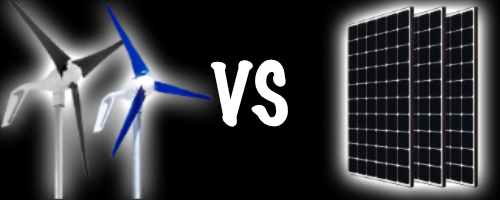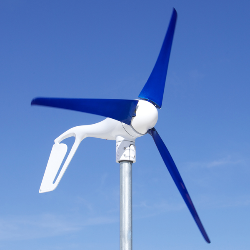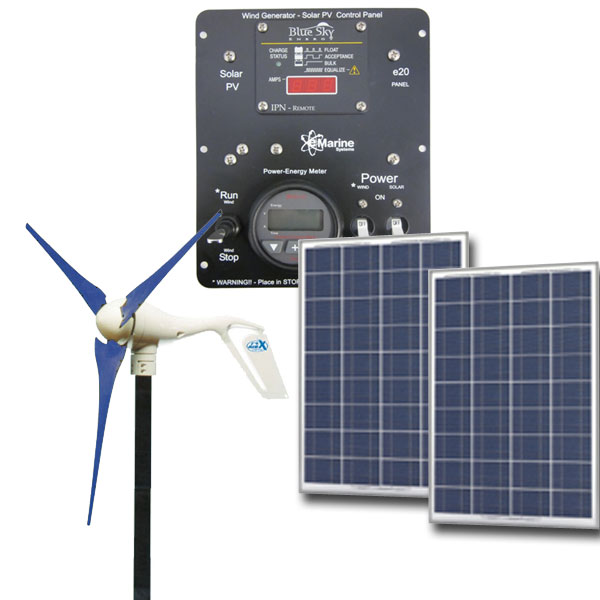Wind Generator vs Solar Panels Which is Better For Your Boat?

I keep my boat on a mooring and want to keep my batteries charged. My sailboat has an outboard and my batteries run down on long weekend cruises. While cruising, I do not like to run my engine so much just to keep my batteries charged. Should I get a wind generator or solar panels for my boat? As with the answer to many questions, it depends. In this case it depends on where you live or where you cruise, or more accurately on the weather where you live or when you cruise. Wind generators need plenty of wind and solar panels need lots of sun. The following will give you some of the pros and cons of each.
 The most important decision when considering a wind generator for boats is determining whether or not there is generally enough wind to generate the power to satisfy your needs and it takes a lot of wind. Along the United States southeast and gulf coast, the average wind speed is less than 10 mph. To be realistic, the output from wind generators needs to be considered for winds between 10 and 12 mph. Along the Texas gulf coast, the average wind speed is higher, but that may be seasonal. The Chesapeake Bay area has a higher average wind speed, but that is a yearly average and most of the higher winds occur in the winter when no one is cruising in that area. The winds in the Bahamas are only slightly higher than the southeast coastal US. You also have to consider where you anchor your boat. We all try to anchor in a lee and get out of the most wind.
The most important decision when considering a wind generator for boats is determining whether or not there is generally enough wind to generate the power to satisfy your needs and it takes a lot of wind. Along the United States southeast and gulf coast, the average wind speed is less than 10 mph. To be realistic, the output from wind generators needs to be considered for winds between 10 and 12 mph. Along the Texas gulf coast, the average wind speed is higher, but that may be seasonal. The Chesapeake Bay area has a higher average wind speed, but that is a yearly average and most of the higher winds occur in the winter when no one is cruising in that area. The winds in the Bahamas are only slightly higher than the southeast coastal US. You also have to consider where you anchor your boat. We all try to anchor in a lee and get out of the most wind.
On gusty days, a wind turbine may put out a lot of power. The power available from the wind varies as the cube of the wind speed. If the wind speed doubles, the power of the wind (the ability to do work) increases 8 times. For example, a 10 mph wind has 1/8th the power of a 20 mph wind (10 x 10 x 10 = 1000 versus 20 x 20 x 20 = 8000). One of the effects of the cube rule is that a location that has an average wind speed reflecting wide swings from low to high velocity may have twice or more energy potential of a location with the same average wind speed which varies very little. This is because the occasional gusts pack a lot of power in a short period of time. Of course, it is important that the occasional gust come often enough to keep up with your power needs.
 Solar panels produce power only when the sun shines. A wind generator on the other hand, has the potential to produce power 24 hours a day. Even if a wind generator produces only 20 watts, it does it 24 hours a day. Higher wind speeds can produce lots of power. Wind generators really produce power when sailing on a reach. The wind coming off the main sail gets directed back to the wind generator at a higher wind speed causing the wind generator to power produce. By the time you get to your anchorage chances are your batteries are fully charged.
Solar panels produce power only when the sun shines. A wind generator on the other hand, has the potential to produce power 24 hours a day. Even if a wind generator produces only 20 watts, it does it 24 hours a day. Higher wind speeds can produce lots of power. Wind generators really produce power when sailing on a reach. The wind coming off the main sail gets directed back to the wind generator at a higher wind speed causing the wind generator to power produce. By the time you get to your anchorage chances are your batteries are fully charged.
The negatives of wind generators are noise produced just by airflow over the blades, the potential danger of rotating blades, and maintenance. Generally the noise from wind generators are not that objectionable. There is a safety factor concerning wind turbines and the danger from the blades. We know of a case where a sailboat with a wind generator spinning pulled into a dock that has very high pilings and the wind generator blades struck the pilings and showered the area with pieces of blades. Some wind generators are self-regulating in high winds, while others require shutting down manually and tying off the blades. Wind generators are mechanical devices and a certain amount of maintenance is required.
The positives on solar panels are that solar panels require little maintenance, last 25 years or longer and are completely safe. There is no noise factor to contend with and panels can stay out in practically any weather. The output production warranty is typically 25 years. while manufacturing warranty can be 6 month to 1o years. Most solar panel manufacturers will not warranty solar panels installed on boats or RV's. Solar panels, including charge controller and mounting hardware, are generally less expensive than a wind generator.
The negatives on solar panels are the effective charging time, space required, and problems with shadows on a sailboat. On average, solar panels are fully effective only 5 to 7 hours a day, depending where you operate your boat. In south Florida, the effective full sun is 5 hours a day so even though solar panels do charge all the daylight hours, the rated power is produced for only 5 hours. Any power calculations involving solar panels should be based on the effective hours. The available space to mount solar panels is also quite limited on a sailboat. The most common ways to mount solar panels is above the bimini, on a stern rail, above dingy davits, on a pole mount, or on an arch.
Comparisons
|
Wind Generators
|
Solar Panels
|
| Cost
|
$1100 to $1800
|
$400 to $1200
|
| Typical output
|
18 watts x 24 hours = 432 watt-hrs
60 watts x 24 hours = 1440 watt-hrs
* At 15-20 knots 100-250 watts 150 watts x 24 hrs = 3600 watt-hrs
|
60 watts x 6.5 hours = 390 watt-hrs
(2) 120 watts x 6.5 hours =1560 watt-hrs
|
| Maintenance
|
Routine maintenance required
|
No routine maintenance required
|
| Danger
|
Mostly in high wind
|
Low - no moving parts
|
| Warranty
|
1 to 5 years
|
0 to 10 years
|
A wind generator or a solar panel can save fuel. The engine in a boat drinks almost as much fuel while just charging batteries as when motoring. Running an engine just to charge batteries can be tough on engines. An engine in a boat is generally not built to run efficiently below its rated level. Low level running causes excessive build-up on valves, shortening engine life. Instead of revving up all those RPM's just to charge batteries, it is much better to charge batteries with a wind generator or solar panel, or both.
A wind generator or a solar panel can also be a safety backup. If your engine is disabled or you have an outboard without charging ability and your batteries run down, at least you have power to run a radio or other instruments. After a few hours, you may have enough charge to start the engine.
 The best alternative may be a blended system with both a wind generator and a solar panel. When in the Bahamas earlier this year, we had five cloudy days with little direct sun but the wind blew 15 to 20 knots. Those cruisers with wind generators were able to keep their batteries charged, but those with only solar panels had to run their engine to charge the batteries. Later, we had days where the wind was very light and the days were very sunny. Having both would protect your independence from having to continually charge your batteries by running your engine.
The best alternative may be a blended system with both a wind generator and a solar panel. When in the Bahamas earlier this year, we had five cloudy days with little direct sun but the wind blew 15 to 20 knots. Those cruisers with wind generators were able to keep their batteries charged, but those with only solar panels had to run their engine to charge the batteries. Later, we had days where the wind was very light and the days were very sunny. Having both would protect your independence from having to continually charge your batteries by running your engine.